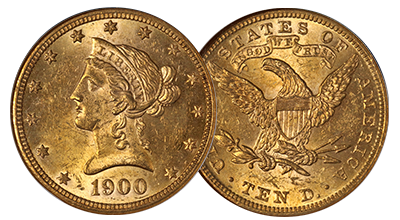U.S. Gold Coins: $10 Gold Coin FAQs
The Eagle underwent several design changes during its production, resulting in different types:
Capped Bust to Right, Small Eagle (1795-1797): This was the initial design of the Eagle.
Capped Bust to Right, Heraldic Eagle (1797-1804): This design featured a larger, more heraldic eagle on the reverse.
Liberty Head (No Motto) (1838-1866): After a hiatus in production, the Eagle was reintroduced with a design depicting Liberty wearing a coronet with "LIBERTY" inscribed on it, with no motto above the eagle on the reverse.
Liberty Head (With Motto) (1866-1907): Similar to the previous design but with the addition of the motto "IN GOD WE TRUST" above the eagle on the reverse.
Indian Head (1907-1933): This design, introduced in 1907, showcased a left-facing Native American head on the obverse and a standing eagle on the reverse.
Production of the Eagle was halted in 1933 due to the U.S. leaving the gold standard and the subsequent gold recall by the U.S. government.
Yes. Each design has many levels of population rarities and condition raresties with a stand alone king.
Here's a brief overview of key coins for the various $10 gold Eagle designs:
Capped Bust to Right, Small Eagle (1795-1797):
The 1795 issue, especially in high grades, is particularly desirable due to it being the first year of issue. Capped Bust to Right, Heraldic Eagle (1797-1804):
The 1804 issue is a significant rarity. Although dated 1804, no Eagles were actually struck in that year. They were struck later, primarily for diplomatic presentation purposes. Liberty Head (No Motto) (1838-1866):
The 1875 issue from the Philadelphia Mint is a key date due to its extremely low mintage. Liberty Head (With Motto) (1866-1907):
The 1870-CC (Carson City) issue is a key date and is highly sought after due to its rarity and the allure of the Carson City Mint. Indian Head (1907-1933):
The 1933 issue is extremely rare and valuable. While a small number were minted, very few were released into circulation before President Roosevelt's gold recall order, making them highly sought after by collectors.
It's worth noting that the rarity and value of a coin can also be influenced by its condition, provenance, and other factors. Additionally, while these are some of the key dates, there are other dates and mint marks within each series that are also considered rare or desirable to collectors.
The $10 gold coin, known as the "Eagle," was produced at five U.S. Mint facilities over its history. Specifically, the Eagle was minted at the following locations:
Philadelphia Mint (P or no mintmark): The primary and original mint facility, located in Philadelphia, Pennsylvania, produced Eagles for much of the coin's production history.
New Orleans Mint (O mintmark): Located in New Orleans, Louisiana, this mint produced Eagles intermittently between 1841 and 1906.
San Francisco Mint (S mintmark): Situated in San Francisco, California, this mint began operations in 1854 and produced Eagles in various years from its inception until 1930.
Carson City Mint (CC mintmark): Located in Carson City, Nevada, this mint produced Eagles from 1870 to 1893.
Denver Mint (D mintmark): Located in Denver, Colorado, this mint produced Eagles starting in the early 20th century, specifically from 1906 to 1931.


